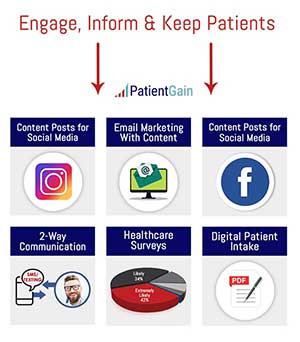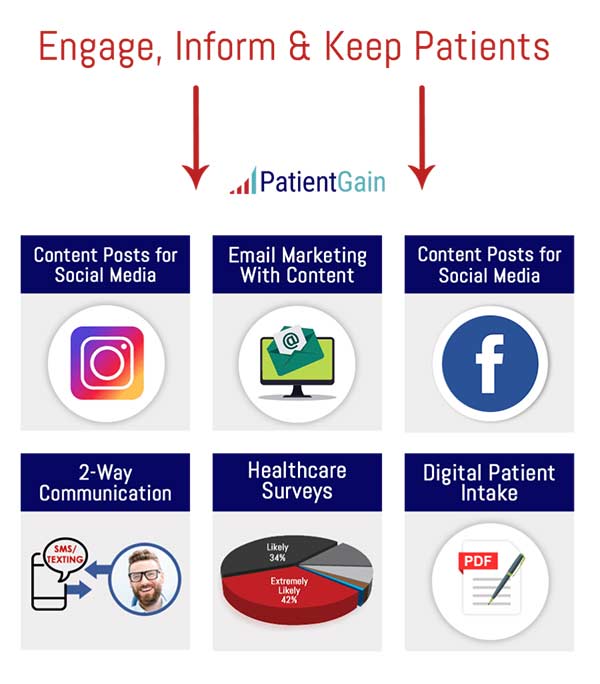How to Acquire & Get New Patients For Your Dental and Medical Practice
Your overall healthcare marketing strategy should be based on best practices and on a pattern of success of other similar medical practices. It should not be based on trial-and-error, and waste of your hard earned money. This is why PatientGain has created many services to benefit healthcare providers.
4 step process used by top healthcare practices is outlined. Costs $799/mon with awesome customer service GOLD service. If you are located in a competitive area, then you will need PLATINUM service. Whether you have a dental practice, surgeon, primary care or any other healthcare practice, these strategies apply to you. PLATINUM service by PatientGain is a single platform solution for your medical and dental practice. It is a proven medical and dental marketing automation solution, based on AI agents, apps, HIPAA compliance.
It includes 1) SEO optimized fast loading HIPAA compliant WordPress website 2) marketing apps 3) advertising apps 4) conversion tracking apps 5) patient communication apps 6) HIPAA compliance 7) project manager 8) technical staff 9) service and apps are a part of the solution, so you have minimum technical involvement. 10) automation and awesome customer service results in very high ROI and customer happiness. Hundreds of practices and thousands of providers use this service everyday.
Example 1: Primary care practice that offers Semaglutide medical weight loss treatments for patients. If you see the leads funnel dashboard below, you will see that in the month of May, 849 new leads were acquired. This customer is using the PLATINUM monthly service.
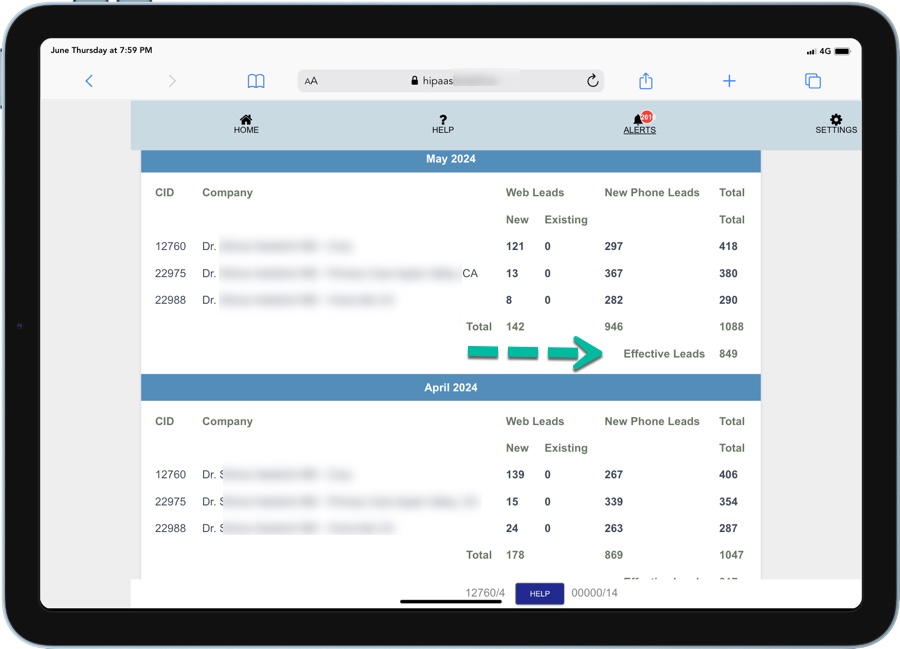
Example 2: Pain clinic located in a very competitive Texas city. During October 794 new patient leads were acquired. This customer is using the PLATINUM monthly service.
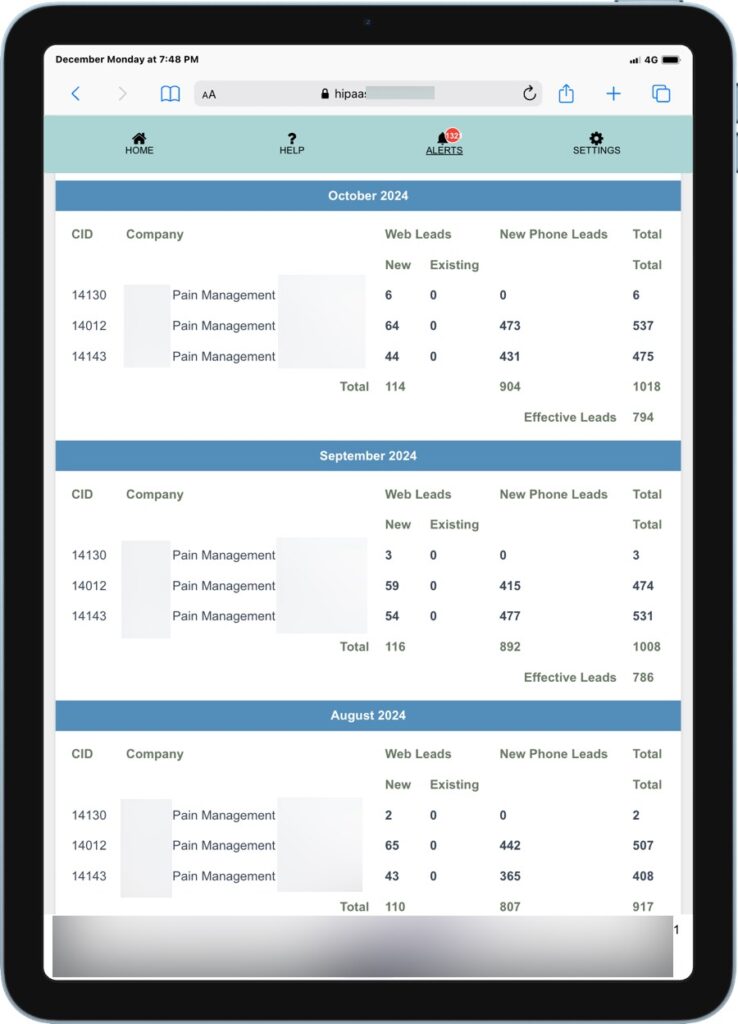
There are 4 prerequisites before you launch on your journey to get new patients for your clinic:
1. You must focus on providing high quality patient care, and genuine focus on high patient satisfaction.
2. Understand there is no “quick solution” – and that anything that is going to produce long term success, is not simple and easy. It will cost time and money. Basically there is no free lunch in the business world.
3. You must have an excellent website, the website must be intelligent and focused on conversion. And extremely good presence on Google SEO. This also includes Google My Business (GMB) optimization for your healthcare practice.
4. Build trust and loyalty with patients. As the practice owner, your patients and your staff want your attention, your focus, your gratitude, you are an example in their eyes. Listen to your patients, be patient with your patients, don’t interrupt your patients to “get to the point.” Listen to them, ask clarifying questions, and pay attention to nonverbal cues like body language.
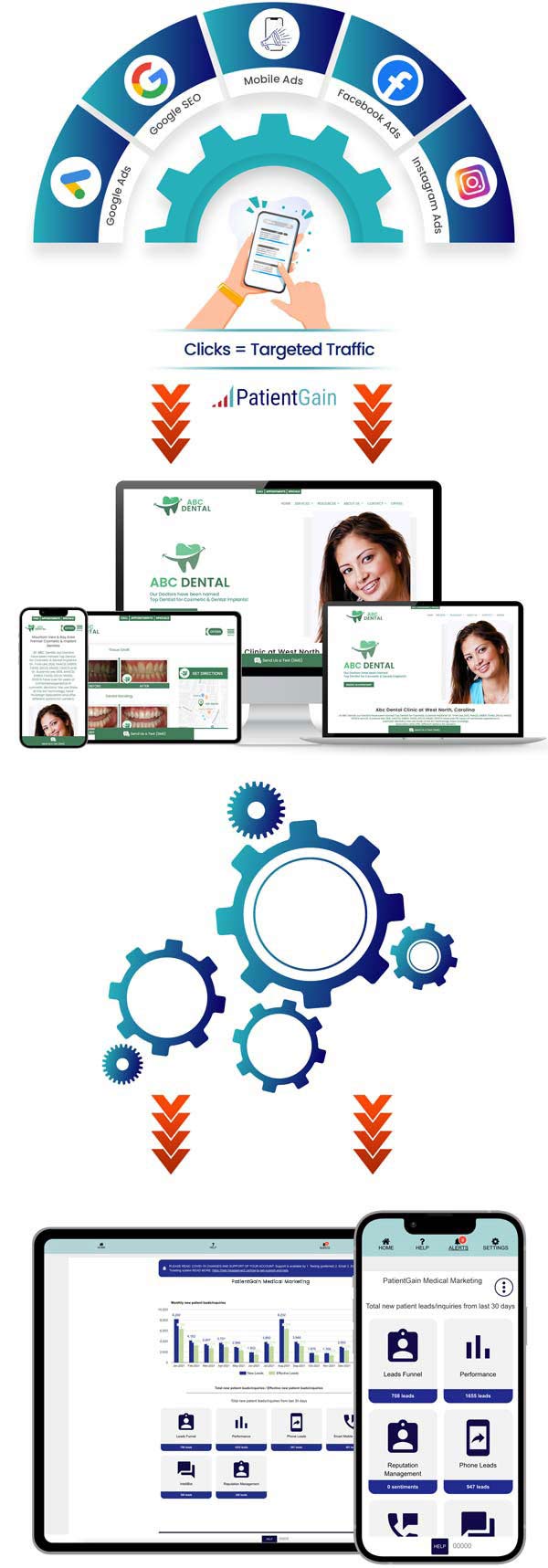
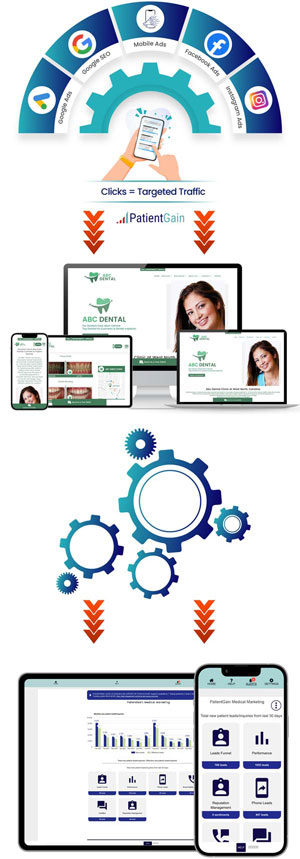
Question: Where do new patients come from?
Top sources of new patients: (Online, digital)
1. Google PPC ads (immediate results – costs money and is complex)
2. Google Organic SEO (takes time to establish – costs money and time and is complex, but produces the best ROI for your marketing dollars)
3. Google Local SEO (depends on your presence on directories like 1. Google Business Page 2. Facebook Business Page 3. Yelp Business Page. 4. There are additional 10 key websites ). Google My Business (GMB) is considered to be a part of Local SEO. Learn how to setup GMB for your patient acquisition.
4. Facebook ads (immediate results – costs money)
5. Instagram ads (immediate results – costs money)
6. Online ads on related sites (for example HealthGrades, RealSelf, Psychology Today)
Top sources of new patients: (Offline, traditional )
1. Simple Human Touch. Simply speak with patients. Listen to them. Build relationships and your staff should make them feel welcomed in your practice. Technology and automation has its place but caring and empathy has no replacement.
2. Referral Marketing (slow results – costs time and effort and constant relationship building)
3. Networking (slow results – costs time and effort and constant relationship building)
The 4 Step Process:
Step 1. Getting patients to your dental or medical website
This refers to digital advertising, SEO and social media activities to let potential patients know that you exist, and that you offer an important service for patients who are looking for your services. Google ads, medical SEO for your website are probably the most important 2 steps you can take. Without proper online advertising plan and robust medical SEO, it is simply hard to grow. This is a very good page that covers good medical advertisement examples.
Here the top marketing channels to get a potential patient to visit your website.
- Google advertising – primarily PPC ads for medical practices
- Facebook advertising – visual targeted ads help you acquire new patients (depending on your practice)
- Instagram advertising – visual targeted ads help you acquire new patients (depending on your practice)
- Google SEO – very effective, but it takes a lot of time, money and effort
- Google local SEO – Google promotes and ranks local businesses in maps and GMB listing – so it will take a very long time so show up higher in local SEO results
- Targeted ads and presence on certain websites. For example, if you offer mental health services, then displaying your ads on websites very specific to mental health will help you.
- Referral websites – For example, if you are a physician who offers pediatric urgent care services for children after normal business hours, you may want to partner with local pediatric and primary care doctors who are not open after normal business hours and weekends.
- Schools and other organizations. Everyday, thousands of children get hurt in schools. Many times it is sufficient to have a telemedicine session with a physician, rather than sending a child to a physician. Not every school has a “nurse” available.
Step 2. Conversion
Once a patient lands on your website, then the website has to do the selling. Many doctors and practice managers naively believe that once a patient lands on your website, they will automatically take an action to contact you. In real life it does not work like this. Only a percentage of the patients who visit your website, will actually request a an appointment, telemedicine session, or call you. Fewer will pay you. An even fewer will show up, even with pre-paying you and even with “confirming” the session. It is a human (patient) behavior.
Examples of a patient conversion on your healthcare website:
- Patient calling you from the phone number listed on the website
- Patient requesting an appointment from the website
- Patient registering for the patient-portal account
- Patient starting a ChatBot session from the website site
- Patient sending a Text/SMS from the website texting app for a 2-Way texting session
- Patient clicking on “Directions” app (for an urgent care or a walk in clinic)
- Patient filling out patient registration form on the website
- Patient signs up for your monthly newsletter
- Patient redeems a promotion from the promotions app
Best conversion medical websites are based on A/B tested software and algorithms. It is tiresome and expensive to create a high conversion website for doctors. Best conversion medical websites have these qualities:
- Intelligence – this refers to conversion intelligent apps on your website to cause the person to take an action. One example is HIPAA compliant medical chatbot.
- Content – The content of your medical website should promote three main areas 1. Your medical practice 2. Your patient services 3. Your providers, doctors and staff. Content should be written as you are speaking to the patient. Focus of the content should be to provide useful information for a patient AND it should also mention and softly “sell” benefits.
- Layout – and structure of the website should be designed with A/B tested layout and design. If you have a pretty website and you are not getting good leads, it could lack of A/B tested design.
- Allow patient to select a time for the telehealth session. Appointment app is a good option.
- Allow patient to fill out the paperwork online (digital intake forms), upload insurance card etc.
- Allow patient to make a payment online using online payment app.
Step 3. Delivering the service to the patient
As a medical provider or a practice manager, this is your responsibility.
Most providers deliver in-person healthcare services, however telemedicine is on the rise also.
Step 4. Patient Engagement, reputation management & measuring your success
After delivering the service, you would still need to to few more steps:
1. Send a patient survey. (Healthcare Survey App)
2. Send a review request. (Reputation Management App)
3. Send a thank you Email. (Thank You App)
4. Patient is added to the monthly Email marketing campaign
5. PatientGain’s CRM can be integrated with your EMR/EHR/PM system
6. Patient is added to the referral request campaign.
5 Specific Steps For Patient Acquisition:
To acquire new patients for your medical practice effectively, consider the following integrated strategies:
- Optimize Online Presence:
- User-Friendly Website: Ensure your site is mobile-friendly, easy to navigate, and includes essential information like services, insurance details, and patient testimonials.
- SEO: Use relevant keywords to boost search engine visibility.
- Online Listings: Claim and update your practice’s profiles on directories like Google My Business and Healthgrades.
- Social Media Marketing: Engage with potential patients by sharing informative content and interacting on platforms like Facebook and Instagram.
- Build Relationships:
- Patient Referrals: Implement a referral program with incentives for patients who bring in new clients.
- Professional Networking: Connect with local healthcare providers and community businesses that can refer patients to you.
- Community Outreach: Increase visibility by participating in community events and offering free screenings.
- Enhance Marketing and Advertising:
- Targeted Advertising: Use Google Ads and social media ads to reach specific demographics.
- Content Marketing: Establish authority by creating and sharing informative content related to your field.
- Free Consultations: Attract new patients with free initial consultations or discounts.
- Focus on Service Quality:
- Patient Care: Provide exceptional care to enhance patient satisfaction and foster referrals.
- Convenience: Offer flexible scheduling and easy communication channels.
- Monitor and Adjust:
- Analytics: Regularly analyze the effectiveness of your strategies to adapt and improve.
Combining these approaches will help you attract new patients, enhance patient satisfaction, and ultimately grow your medical practice. Consistency in execution and a commitment to quality care are crucial for long-term success.
Common questions asked by practice managers of a medical or a dental practice:
How can pay-per-click advertising help a dental and medical practice attract new clients?
Pay-per-click advertising is very literal when it comes to the concept of this advertising method. A dental practice will pay for every click someone makes on one of their online ads. These ads will appear in search engine results when potential patients use specific keywords to search for dental health solutions. Pay-per-click (PPC) ads have an advantage over organic results because they are the first thing someone sees in their search results. Many search engine users will explore the paid ads first before moving on to other areas of the returned results. If a dental practice can get their name front and center first before anyone else’s, they have a competitive advantage.
For a PPC ad to be effective, the ad copy needs to catch their attention. For example, if someone is looking for a dentist that gives root canal treatments, the words “Root Canal” definitely need to appear in the ad copy. With the remaining space in the ad, a dental practice can choose to promote the cost savings, how easy it is to make an appointment, or how pain-free the treatment is, among other things. The goal is to catch their attention and make a click before a potential patient explores more results. The destination of that click also needs to be relevant. A practice will see higher conversion rates for their ads if people are sent directly to a page connected to the ad copy, like a root canal service page. They will see fewer conversation rates for ads that send visitors to a generic landing page or an utterly off-topic page.
Some dental practices choose not to run PPC campaigns if their organic rankings are excellent and appear high in search results. However, if the budget allows, it may be a good idea to continue to put some money into PPC ads. If a dental practice does not, it gives up space for competitors to move in and advertise without any competitive pressure. It is also a powerful message to advertise if a dental practice appears in paid ads and organic results. With that in mind, if a dental practice can no longer accept any new patients, then it is wise to pause any PPC campaigns, perhaps until additional capacity for new patients is available.
How can social medial help dental and medical practices increase their patient count?
Social media is now a part of just about everyone’s life. It has grown tremendously over the last 20 years, and it is much more uncommon today for someone to have no social media profile. Businesses, including dental practices, should have a presence on social media. Today, having no social media accounts is like not having a business card. Yes, a business can probably function without them, but many people will find it odd that they do not have one. While there are many social media channels out there, most dental practices will be best served by having accounts on Facebook, Instagram, Twitter, and a Google Business Profile. These accounts are also the most common accounts that social media posting services will connect to so that someone can post the same thing across several accounts without logging in to each of them.
When posting content on social media, it is essential to remember that current and potential patients do not want always to be “sold to” when they log into their accounts. With that in mind, limit posts that are just promoting a service at a dental practice. That is undoubtedly different if a new service is offered or a new aspect to a previous service is available. However, avoid making a daily post covering a few different services. Include posts about local news, local schools, regional health stories, and national health stories. A social media channel should be seen as a source of reliable medical information. Other posts that often get excellent traction and shared are pictures and video posts from the clinic. If these posts feature staff and providers, they are often commented on by patients who have had positive experiences with them in the past. Theses posts may even be shared across different profiles!
Social media channels also have a powerful marketing platform that dental practices can promote their business to local audiences. While the reach of social media advertising is smaller than search engine advertising, it can still be quite effective. While social media advertising and search engine advertising allow someone to target an audience by location and keywords, social media platforms will enable a business to refine it even more! Social media ads can target someone by their gender, age, and interests. If used correctly, the target audience will be very receptive to a marketing message.
How can managing online reviews help advertise a dental and medical practice?
When a potential patient sees a listing for a dental practice and explores its website (maybe even before exploring it), they will look over the past reviews from patients. Reviews can often make or break a dental practice and make it very expensive to acquire new patients. As such, it is in their best interest that these be monitored and managed. Since most of these reviews are posted on Google and Yelp, the first step is to claim or create listings in these directories. While it does take a few steps to verify a claim of a listing on a site, it should not take too long for a dental practice to access its reviews.
One part of managing online reviews is to respond to them. A simple thank you for their visit is more than enough to acknowledge their kind words for positive reviews. Extra care needs to be made when addressing negative reviews. If possible, try to contact the upset patient before posting a reply to a review. A dental practice may be able to resolve their issue and have them change their review. If they do not, the response can thank them for talking to them one-on-one about their experience. If the identity of the bad reviewer can not be determined, ask them to contact the practice so they can discuss their visit. Regardless if the review stays, is changed, or is taken down, the goal is to show potential patients that feedback is taken seriously. It will show that the owner wants to offer the best service possible. Ignoring bad reviews or attacking them in responses often does not paint a dental practice in a good light.
The other part of managing reviews is to cultivate new, positive reviews. Often the best way to deal with negative reviews is to outnumber them with positive reviews vastly. Many potential patients expect to see a few 1-star reviews in a sea of 5-star reviews. The easiest way to get a good review from a patient is to ask them! Provide them with a link to leave a review. Ideally, it should be as few clicks or steps as possible. For each additional step, there is to leave a review, more and more patients will abandon the process. Preferably, one click should be all that is needed to start the review process. When sending a review link, many practices either use email or text messages. Email requests are cheaper than text messages, but text requests have a much higher conversion rate. Some dental practices use both to ensure they get as many good reviews as possible!
Is dental SEO (Search Engine Optimization) considered digital advertising?
Technically, dental SEO is not considered to be advertising. However, majority of dental providers and practice managers of dental practices, consider dental SEO of their website as one of the most important part of their advertising plan. Basically 100% of the dentists and dental practice managers want high SEO rankings for their company. So it is “advertising”.
PatientGain.com is a proven new patient marketing solution, includes apps, websites, SEO, HIPAA compliance and account management.
